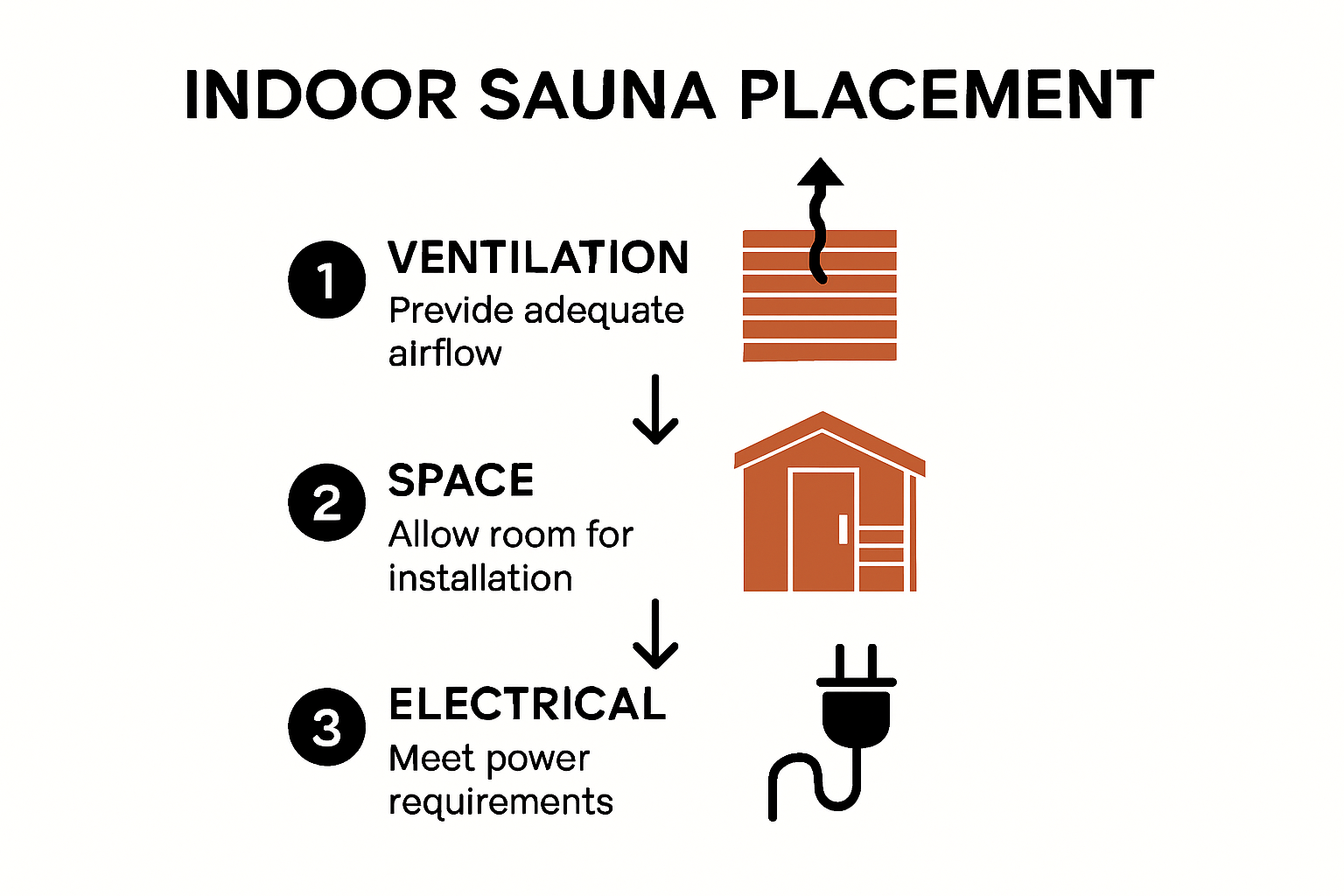
Where to Place Sauna Safely in Your Home
 Finding the right spot for a sauna in your home can enhance your wellness experience significantly. Did you know that basements and bathrooms are the most preferred locations for indoor saunas due to their ability to manage moisture and provide privacy? But here’s the kicker: the space you choose can dramatically affect your sauna’s functionality and safety. The best location isn’t always the most obvious one; sometimes, unconventional spaces are the key to maximizing your wellness investment.
Finding the right spot for a sauna in your home can enhance your wellness experience significantly. Did you know that basements and bathrooms are the most preferred locations for indoor saunas due to their ability to manage moisture and provide privacy? But here’s the kicker: the space you choose can dramatically affect your sauna’s functionality and safety. The best location isn’t always the most obvious one; sometimes, unconventional spaces are the key to maximizing your wellness investment.
Table of Contents
- Ideal Indoor Spots For Sauna
- Outdoor Sauna Placement Factors
- Critical Area Preparation Before Install
- Common Sauna Placement Mistakes
Quick Summary
| Takeaway | Explanation |
|---|---|
| Choose Ideal Locations | Basements and bathrooms are preferred spots for indoor saunas due to privacy, moisture management, and convenience. Utility rooms and walk-in closets are alternative solutions for limited spaces. |
| Plan for Proper Ventilation and Electrical Setup | Adequate ventilation is crucial to prevent moisture buildup and ensure comfort. Additionally, most saunas require dedicated electrical circuits, emphasizing the need for professional installation to meet safety codes. |
| Consider Outdoor Placement Carefully | When installing an outdoor sauna, assess terrain, ensure proper spacing from combustible materials, and take into account wind protection and utility access for an optimal sauna experience. |
| Prepare the Installation Area Thoroughly | A stable foundation, correct electrical setup, and appropriate insulation are essential for both indoor and outdoor sauna installations, influencing long-term safety and performance. |
| Avoid Common Placement Mistakes | Common errors include improper electrical setup, poor ventilation, and miscalculating space requirements. Professional consultation can help prevent these costly mistakes and ensure a safe sauna environment. |
Ideal Indoor Spots for Sauna
Choosing the right location for your indoor sauna involves careful consideration of space, functionality, and home design. While saunas offer incredible health benefits, their placement can significantly impact both your wellness experience and your home’s overall functionality.
Strategic Home Spaces for Sauna Installation
Homeowners have multiple attractive options when determining where to place a sauna indoors. The key is selecting a location that provides convenience, privacy, and proper environmental conditions. Basements, bathrooms, and utility rooms emerge as top contenders for sauna placement.
Basements offer an ideal environment for sauna installation due to several unique advantages. These underground spaces typically provide consistent temperatures, natural privacy, and minimal disruption to primary living areas. According to Architectural Digest, basement saunas can be easily integrated without compromising primary living spaces, making them a smart choice for homeowners seeking dedicated wellness areas.
Bathrooms represent another excellent location for indoor sauna placement. The proximity to shower facilities makes post-sauna cooling and hygiene routines seamless. Home & Design Experts recommend ensuring adequate ventilation and waterproof flooring when considering bathroom sauna installations. These spaces naturally accommodate moisture management and provide immediate access to water and cleanup resources.
Critical Considerations for Indoor Sauna Placement
Before finalizing your sauna location, several critical factors must be evaluated. Ventilation stands as the most crucial element in successful indoor sauna placement. Proper air circulation prevents moisture buildup, potential mold growth, and ensures a safe, comfortable environment.

Space requirements vary depending on sauna type. Infrared saunas typically require less square footage compared to traditional steam saunas. Measure your intended space carefully, accounting for not just the sauna unit’s dimensions but also necessary clearance for safe entry, exit, and potential surrounding amenities.
Electrical considerations cannot be overlooked. Most indoor saunas require dedicated electrical circuits to support their heating elements. Electrical Safety Foundation recommends consulting a licensed electrician to ensure proper installation and compliance with local building codes. This step prevents potential electrical hazards and guarantees optimal sauna performance.
Unconventional yet Effective Sauna Locations
For homes with limited space, creative solutions exist. Utility rooms, walk-in closets, and even areas underneath staircases can be transformed into compact sauna spaces. [Innovative Home Design](https://www.homedesig trends.com/space-optimization) suggests these alternative locations can maximize wellness potential without requiring extensive home renovations.
When exploring where to place a sauna, remember that each home presents unique architectural opportunities. The ideal location balances practical considerations like electrical access and ventilation with personal preferences for privacy and convenience. By carefully assessing your home’s layout and your specific wellness goals, you can create a sauna space that seamlessly integrates health and comfort.
 Consult with professional designers and electricians to ensure your chosen location meets all safety and functional requirements. Your perfect indoor sauna placement is just a thoughtful evaluation away.
Consult with professional designers and electricians to ensure your chosen location meets all safety and functional requirements. Your perfect indoor sauna placement is just a thoughtful evaluation away.
Outdoor Sauna Placement Factors
Outdoor sauna placement requires strategic planning that goes beyond simple location selection. Homeowners must consider multiple environmental, structural, and practical factors to create an optimal sauna experience that balances functionality, comfort, and aesthetic appeal.
Terrain and Ground Preparation
Choosing the right outdoor location begins with understanding your property’s terrain and ground conditions. Not all outdoor spaces are equally suitable for sauna installation. Level ground with stable soil composition provides the most reliable foundation for outdoor sauna structures. Landscape Architecture Monthly recommends conducting a thorough site assessment to evaluate potential challenges like drainage, ground slope, and soil stability.
Proximity to existing structures matters significantly. While outdoor saunas offer flexibility, they should be positioned a safe distance from wooden buildings, trees, and combustible materials. Typically, a minimum clearance of 10 feet from other structures ensures both safety and optimal performance. This spacing prevents potential fire risks and allows adequate ventilation around the sauna.
Environmental Considerations and Wind Protection
Wind exposure plays a critical role in outdoor sauna placement. Excessive wind can compromise the sauna’s internal temperature and overall heating efficiency. Climate Design Experts suggest positioning your sauna in areas with natural wind breaks such as existing landscape features, fencing, or strategic landscaping.
Orientation matters more than many homeowners realize. For wood-burning saunas, chimney placement requires careful consideration of prevailing wind directions. Thermal Engineering Research recommends positioning the sauna so that prevailing winds do not interfere with smoke dispersal from the chimney, which could create uncomfortable or potentially hazardous conditions.
Practical Infrastructure and Utility Considerations
Beyond aesthetic and environmental factors, practical infrastructure demands careful evaluation. Electrical and water connections are crucial for many modern sauna designs. Home Infrastructure Quarterly emphasizes the importance of proximity to existing utility connections, which can significantly reduce installation complexity and cost.
Ventilation becomes even more critical in outdoor settings. According to Sauna Technical Guidelines, outdoor saunas require precise ventilation management. Experts recommend installing an inlet vent near the floor beneath the stove and an outlet vent diagonally positioned in the lower third of the room’s internal height. This strategic placement ensures optimal air circulation and temperature regulation.
Accessibility should not be overlooked. Consider creating a clear, safe pathway to your outdoor sauna, accounting for potential weather conditions like snow, rain, or uneven terrain. Proper lighting, non-slip surfaces, and protection from the elements can transform your outdoor sauna experience from functional to exceptional.
Remember that local building codes and homeowners’ association regulations may impose additional restrictions on outdoor structure placement. Always consult local authorities and obtain necessary permits before finalizing your sauna installation plan.
Careful consideration of these factors ensures that your outdoor sauna becomes not just a wellness feature, but a seamlessly integrated element of your home’s outdoor living space. Professional consultation can provide personalized insights tailored to your specific property and wellness goals.
Critical Area Preparation Before Install
Preparing the installation area for a sauna requires meticulous planning and attention to detail. Proper site preparation ensures not just successful installation, but long-term performance, safety, and enjoyment of your wellness investment.
Foundation and Ground Preparation
The foundation represents the critical first step in sauna installation. Whether indoor or outdoor, a level, stable surface is non-negotiable. Construction Engineering Quarterly recommends conducting a comprehensive site assessment that evaluates ground conditions, potential drainage issues, and structural integrity.
For outdoor sauna installations, frost-proof footings become essential. Landscape Design Institute suggests using concrete piers or a reinforced concrete slab that extends below the frost line. This prevents ground shifting and ensures long-term structural stability. The base should be compacted and level, with a recommended gravel underlayment to facilitate proper drainage and prevent moisture accumulation.
Indoor sauna placements require equally careful preparation. Evaluate floor load-bearing capacity, especially for second-floor or basement installations. Hardwood, tile, or concrete floors can typically support sauna weight, but professional structural assessment remains crucial.
Electrical and Utility Considerations
Electrical infrastructure demands precise planning. Electrical Safety Foundation emphasizes the importance of dedicated circuits for sauna installations. Most residential saunas require 220-240 volt electrical connections, necessitating professional electrical work.
Consider the following critical electrical preparation steps:
- Install a dedicated GFCI-protected circuit
- Ensure wire gauge matches sauna manufacturer specifications
- Position electrical connections away from direct water exposure
- Obtain necessary permits from local building authorities
HVAC Engineering Quarterly recommends installing inlet and outlet vents strategically, accounting for room dimensions and sauna type.
Insulation and Environmental Protection
Insulation transforms a basic sauna space into an efficient wellness environment. Thermal Performance Research recommends using high-quality insulation materials like fiberglass or specialized sauna insulation that can withstand high temperatures and moisture.
Critical insulation considerations include:
- Vapor barrier installation to prevent moisture penetration
- Appropriate R-value insulation for your climate zone
- Seamless coverage of walls, ceiling, and potential exterior interfaces
Environmental protection extends beyond basic insulation. For outdoor saunas, consider wind breaks, protective roofing, and surrounding landscaping that shields the unit from extreme weather conditions. Indoor sauna installations should account for potential moisture transfer to surrounding walls and flooring.
Professional consultation remains the most reliable approach to comprehensive sauna area preparation. Each installation presents unique challenges, and expert guidance ensures you avoid potential structural, electrical, and performance complications.
Remember, thorough preparation is not just about immediate installation—it’s an investment in years of reliable, safe, and enjoyable sauna experiences. Take time to plan, consult professionals, and create a solid foundation for your wellness journey.
Common Sauna Placement Mistakes
Sauna placement might seem straightforward, but numerous homeowners inadvertently compromise their wellness investment by overlooking critical design and safety considerations. Understanding common mistakes can help you create a safe, efficient, and enjoyable sauna experience.
Electrical and Safety Positioning Errors
Electrical configuration represents one of the most frequent and dangerous placement mistakes. Electrical Safety Foundation warns that improper electrical setup can lead to significant hazards. Many homeowners fail to install dedicated GFCI-protected circuits specifically designed for sauna equipment, increasing the risk of electrical failures.
Common electrical placement mistakes include:
- Using standard household circuits not rated for high-temperature equipment
- Neglecting proper grounding requirements
- Positioning electrical connections too close to moisture sources
- Failing to obtain necessary electrical permits
Proper electrical placement demands professional assessment. Certified electricians can ensure your sauna’s electrical infrastructure meets current safety standards and manufacturer specifications.
Ventilation and Moisture Management Oversights
Ventilation represents another critical area where placement mistakes frequently occur. Indoor Air Quality Experts emphasize that inadequate ventilation can create dangerous moisture accumulation, potentially leading to mold growth and structural damage.
Most homeowners underestimate the complexity of sauna ventilation. Key placement errors include:
- Blocking natural air circulation paths
- Installing insufficient inlet and outlet vents
- Positioning the sauna in areas with poor air exchange
- Neglecting humidity control mechanisms
Strategic vent placement requires understanding airflow dynamics. Inlet vents should be positioned near the floor, while outlet vents belong near the ceiling to facilitate optimal air circulation and temperature regulation.
Spatial and Environmental Miscalculations
Spatial considerations often lead to significant placement mistakes. Architectural Design Monthly reports that many homeowners miscalculate clearance requirements, potentially compromising safety and functionality.
Frequent spatial placement errors include:
- Insufficient clearance around sauna perimeter
- Ignoring heat radiation impact on surrounding surfaces
- Placing sauna near combustible materials
- Failing to account for floor load-bearing capacity
Professional measurement and consultation can help prevent these critical errors. Precise spatial planning ensures your sauna integrates seamlessly into your living environment while maintaining essential safety parameters.
Remember that sauna placement is not just about convenience—it’s about creating a safe, efficient wellness space. Each decision impacts your sauna’s performance, longevity, and overall user experience. While DIY approaches might seem tempting, professional guidance can prevent costly mistakes and potential safety risks.
Consult with wellness design professionals, electricians, and structural experts to transform your sauna placement from a potential hazard to a perfectly integrated health sanctuary. Your careful planning today ensures years of safe, enjoyable sauna experiences tomorrow.
Frequently Asked Questions
Where is the best place to install an indoor sauna?
Basements and bathrooms are the most preferred locations for indoor saunas due to their ability to manage moisture and provide privacy. Utility rooms and walk-in closets are also viable options for limited spaces.
What should I consider when placing an outdoor sauna?
When placing an outdoor sauna, consider terrain and ground preparation, environmental factors like wind protection, and access to utilities such as electricity and water. Ensure there’s adequate clearance from combustible materials and existing structures.
How do I ensure proper ventilation for my sauna?
Adequate ventilation is crucial for sauna safety and comfort. Install inlet vents near the floor and outlet vents near the ceiling to facilitate optimal air circulation. Consult HVAC professionals for proper airflow design based on your sauna type and space.
What are common mistakes to avoid when placing a sauna?
Common mistakes include improper electrical setup, insufficient ventilation, and miscalculating space requirements. It’s essential to ensure your sauna has dedicated circuits, proper air circulation, and adequate clearance from surrounding surfaces to prevent hazards.
Elevate Your Home Wellness Journey with Best Life Sauna
Choosing the ideal location for your sauna, whether indoors or outdoors, is crucial for maximizing its benefits—from stress relief to improved skin health. Did you know that basements and bathrooms are top preferences due to their moisture management advantages? Yet, many homeowners face challenges when it comes to optimizing space and ensuring safety. Let Best Life Sauna take your wellness journey to the next level by offering premium sauna options tailored to every space and lifestyle!

Explore our diverse range of saunas—including infrared, traditional, and outdoor choices—that align perfectly with the principles discussed in the article. With features such as easy installation guidance, personalized customer support, and a price match guarantee, we make it our mission to ensure you find the perfect sanctuary right at home. Don’t wait: visit Best Life Sauna now to discover how our wellness solutions can enhance your life today! Your ideal sauna experience awaits!
Recommended Articles
- Discover the Best Sauna Designs for Ultimate Home Luxury – Best Life Sauna
- Ultimate Sauna Installation Guide: Home Setup Made Simple – Best Life SaunaBest Life Sauna - Premium Saunas for WellnessAmerican ExpressApple PayDiners ClubDiscoverGoogle PayMastercardPayPalShop PayVisa
- The Cardiovascular Benefits of Sauna Therapy – Best Life SaunaBest Life Sauna - Premium Saunas for WellnessAmerican ExpressApple PayDiners ClubDiscoverGoogle PayMastercardPayPalShop PayVisa
- Discover the Benefits of Outdoor Saunas for Health, Relaxation & Home – Best Life SaunaBest Life Sauna - Premium Saunas for WellnessAmerican ExpressApple PayDiners ClubDiscoverGoogle PayMastercardPayPalShop PayVisa
- 2025 Guide: Must-See Popular Sauna Designs & Trends – Best Life Sauna

